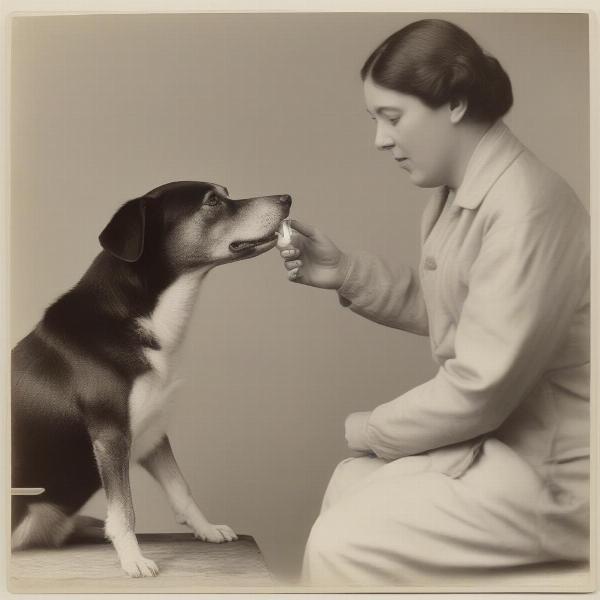Vegetable glycerine, also known as glycerol, is a sweet, syrupy liquid derived from plant oils. It’s found in a variety of products, from food and cosmetics to pharmaceuticals. But what about its use in dog treats and other pet products? Is vegetable glycerine safe for dogs? This article will explore the uses, benefits, and potential risks of vegetable glycerine for our canine companions.
Understanding Vegetable Glycerine
Vegetable glycerine is a humectant, meaning it attracts and retains moisture. This property makes it a popular ingredient in dog treats, as it helps keep them soft and palatable. It also contributes to the chewy texture that many dogs enjoy. Beyond treats, vegetable glycerine can be found in some dog medications and dental care products.
Is Vegetable Glycerine Safe for Dogs?
Generally, vegetable glycerine is considered safe for dogs in moderate amounts. The FDA has classified it as “generally recognized as safe” (GRAS) for both humans and animals. However, like any substance, excessive consumption can lead to potential side effects.
Potential Side Effects of Vegetable Glycerine in Dogs
While rare, some dogs might experience mild side effects from consuming too much vegetable glycerine, including:
- Gastrointestinal upset: Diarrhea, vomiting, and gas are possible, especially if a dog ingests a large quantity of treats containing glycerine.
- Weight gain: Vegetable glycerine is a carbohydrate and contains calories. Overconsumption can contribute to weight gain, particularly in dogs prone to obesity.
- Elevated blood sugar levels: While generally not a concern for healthy dogs, those with diabetes should consume glycerine with caution, as it can affect blood sugar levels.
Using Vegetable Glycerine for Dogs: What to Watch For
When choosing treats or other products containing vegetable glycerine for your dog, keep the following in mind:
- Moderation is key: As with any treat, offer glycerine-containing products in moderation as part of a balanced diet.
- Check the ingredient list: Look for “vegetable glycerine” or “glycerol” on the ingredient list. Be mindful of the overall sugar content of the treat.
- Consult your veterinarian: If your dog has any underlying health conditions, particularly diabetes, consult your veterinarian before introducing treats or products containing vegetable glycerine.
- Observe your dog: After introducing a new treat, monitor your dog for any adverse reactions, such as digestive upset or changes in behavior.
Vegetable Glycerine in Dog Medications and Dental Care
Vegetable glycerine is also used as a sweetener and binding agent in some dog medications, making them more palatable. It can also be found in certain dental care products, contributing to a smooth texture and helping ingredients adhere to the teeth.
 Dog Taking Medication Containing Glycerine
Dog Taking Medication Containing Glycerine
Is Vegetable Glycerine Safe for Dogs with Allergies?
Vegetable glycerine is typically derived from plant oils like palm, coconut, or soy. If your dog has a known allergy to any of these, it’s essential to choose products made with glycerine derived from a different source.
Homemade Dog Treats with Vegetable Glycerine
Some dog owners enjoy making homemade treats using vegetable glycerine. This allows them to control the ingredients and tailor the treats to their dog’s specific needs. However, it’s crucial to follow reputable recipes and use food-grade vegetable glycerine.
Conclusion
Vegetable glycerine is generally safe for dogs and offers several benefits in pet products, from maintaining treat palatability to aiding medication administration. However, it’s important to practice moderation and monitor your dog for any potential side effects. By understanding the uses and potential risks, you can make informed choices about incorporating vegetable glycerine into your dog’s diet and care routine.
FAQ
-
What is vegetable glycerine made from? Vegetable glycerine is derived from plant oils, such as palm, coconut, or soy.
-
Can too much glycerine be harmful to my dog? Excessive consumption can lead to digestive issues, weight gain, and potentially affect blood sugar levels.
-
Is glycerine safe for diabetic dogs? Consult your vet before giving glycerine to a diabetic dog, as it can impact blood sugar.
-
Why is glycerine used in dog treats? It acts as a humectant, keeping treats soft and moist, and adds a chewy texture.
-
Can I use human-grade glycerine for my dog? Always use food-grade vegetable glycerine intended for animal consumption.
-
Are there any alternatives to vegetable glycerine in dog treats? Other humectants like honey or molasses can be used, but in moderation due to their sugar content.
-
Where can I buy vegetable glycerine for making homemade dog treats? Food-grade vegetable glycerine can be purchased at health food stores or online.
ILM Dog is your trusted source for expert advice on dog care, breeds, health, training, nutrition, grooming, and more. We offer valuable resources for both new and experienced dog owners worldwide, focusing on practical, reliable information that caters to diverse cultural backgrounds. Learn more about caring for your canine companion and explore our range of products and accessories by visiting us at ILM Dog. Contact us at [email protected] or +44 20-3965-8624.